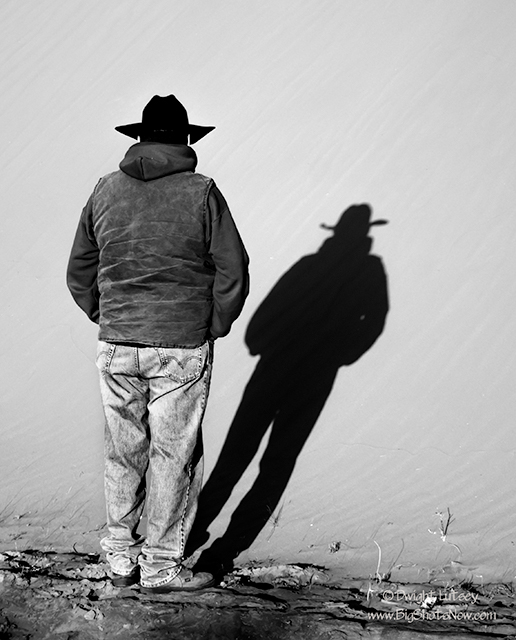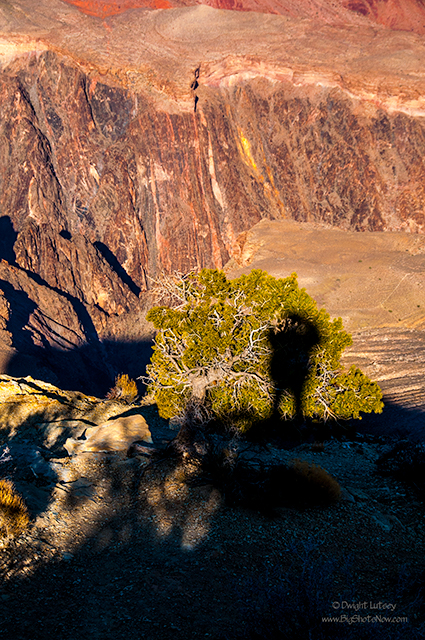Shadowglyphs, according to our dictionary of Scientific terms, are a little-known phenomenon where an individual or animal or some other type of life will leave an imprint of its shadow on a vertical or semi-vertical surface that is not visible after the individual making it leaves.
Here we see a humanoid type individual in the act of creating a shadowglyph on a sand dune in Monument valley. As you can see the shadow is very dark and heavy indicating that it is in the final act of exposure and consequently will be a very strong shadowglyph upon its completion.
You may be asking yourself “Well hey, what about these things, why haven’t I, a keen observer of strange and unusual phenomenon seen this before then. I read the Star and the Inquirer. How is it you guys, at the foremost Photographic Institute in the entire world, are the very first to discover this?” Well, you’ve answered your own question. We are the foremost Photographic Institute in the world, what did you expect?
It’s a simple answer really, but one with an incredibly complex back story. The simple part is we developed, with the help of the NSA and The National Endowment for the Arts, a grant from The Society of Photographers Equipment Development, or ‘SPED’, plus donations from readers like you, a special new camera. This camera has the ability to photograph a scene and through the innovations of dozens of technicians, engineers and other smart people capture the Shadowglyph that exists, indelibly etched on the surface of the view you are photographing, even when you can’t see it with your naked eye.
As amazing as this is we know that are probably a few skeptics in the crowd that don’t believe that this is possible, so the image below, one of the first of its kind ever published in a legitimate scientific publication like ours, shows the results of our success.
Here you can easily see the outline of a passing photographer that has been imprinted on some foliage when there is now no photographer present. Without the aid of our special camera you can not see this shadowglyph. There is simply a bare bush standing there with no sign that there is a shadowglyph imprinted on its surface. Pretty darn impressive right?
We have anticipated one of the questions we’re sure to be asked by the world at large and that would be “So what’s the difference between a Shadowglyph and a Petroglyph then?” and we say “Absolutely nothing!” they’re just different forms of the same thing. What you see as a petroglyph is simply a shadowglyph that has, over time, become corrupted and due to its inherent composition has become visible. It has etched itself into the rock surface by a slow acting chemical process know as desilica-implosion. This is when the molecules of the shadowglyph that has adhered to the rocks surface gradually builds up a pressure due to constant heating and thawing by the sun until it results in the rock under the molecule exploding outward from the surface. This leaves a small crater where the molecule was, that appears as if it might have been formed by something harder than the rock surface, striking that surface repeatedly. This is where the confusion and mistaken idea that these petroglyphs were formed by a small lost, but destructive, ancient person, spending his days hammering this information into the stone, and defacing the countryside. Not so. Wasn’t him. It was desilica-implosion. Now we can let this little ancient vandal off the hook.
Accepting this explanation as valid truth and following this logic to its absolute conclusion we feel then that every petroglyph is actually a perfect record of the being that made it. Kokopelli’s, and those tall flat people with bubble heads you see on the walls sometimes, all of those sheep, the circle-ly things and squiggly lines that appear everywhere, they all existed and cast their likeness’ on the walls around them.
We know that this is going to stand the Archeology world on its head but we don’t give a fat, flying donut, we are in the process of developing a new type of dating method similar to the old-fashioned carbon dating method that is so old hat today. We call this new process Photon-dating and we are certain that this new revolutionary development will conclusively prove our theory. Using yet another newly developed piece of equipment, which we have named our “Highly Effected Slow Down Process Camera” or the ‘HESDP’ camera for short, (which is yet one more innovation from the folks here at The Institute) and after making the proper settings and adjustments needed, this equipment and its process effectively slows down the frame-rate at which the specially outfitted camera can take pictures, causing it to take those pictures in slow-motion so it can document the actual crater being created in the act and catch the photons responsible for it in mid-flight. These photons can then be measured and by comparing the results to a chart that is part of our proprietary knowledge, determine when the event occurred. We hope to refine this process to the point where we can reverse the petroglyph back to its original shadowgraph while gleaning all the information possible from its blackness, and then erase the shadowglyph from the rock and store it in a box down in our archives somewhere. The Smithsonian can’t do that.
One of the ways that you can see this phenomenon of shadowglyphs on your own, without government intervention, is to look back through your own photographs. Occasionally you will find one that is totally black. You may have thought that you left the lens cover on when you took the picture, or that you used the wrong exposure or that your three-year old completely filled your lens hood with peanut butter so you’d have a snack later, but if you enlarge that image dramatically, enlarging it to the point where you can suddenly see that the blackness is actually tens of thousands, if not millions, of individual shadowglyphs stacked and piled, one on top of the other, (note: you might need a micron microscope for this) you will see why your image appears to be completely black. It’s not black because you screwed up, it’s black because of the huge pile of shadowglyphs on that particular surface. See, you don’t totally suck at picture-taking, you just didn’t have a sophisticated enough camera.
How is this possible for you to take picture of shadowglyphs when you don’t have the proper equipment and without using our special camera? It happens because there are some places where there have been so many shadowglyphs formed and piled and stacked etc, that even an unsophisticated camera like you have can begin to pick them up. Count yourself lucky. Even though you had no clue, you were discovering shadowglyphs, the imprint of countless others that have been here before you. Kind of gives you Goosebumps doesn’t it?
Of course after submitting our findings for publication with the mainstream scientific press we have already begun receiving rejection notices from other less prestigious publications, like Nature, and Scientific American, with emphatic refusals to print our findings, not to mention receiving derisive comments and responses to our new discoveries from the scientific community at large, but we were expecting that. They laughed at Galileo, and Ed the guy down the street, and Einstein, telling him to comb his hair. They laughed at that cold-fusion guy, but actually that was pretty funny, we laughed at him too, but did they care? We don’t think so. These are jealous bitter people we’re dealing with here. They’re entrenched in their narrow view of what can and can’t be and refuse to confronted with new facts. But we intend to push forward. The world is full of unexplained things and we intend to explore them and provide answers. Just like we have been doing since our inception. After all we are The Institute. Watch for more newly discovered stuff and learn the answers to all those niggly little things you’ve been wondering about. Or maybe not.



You must be logged in to post a comment.